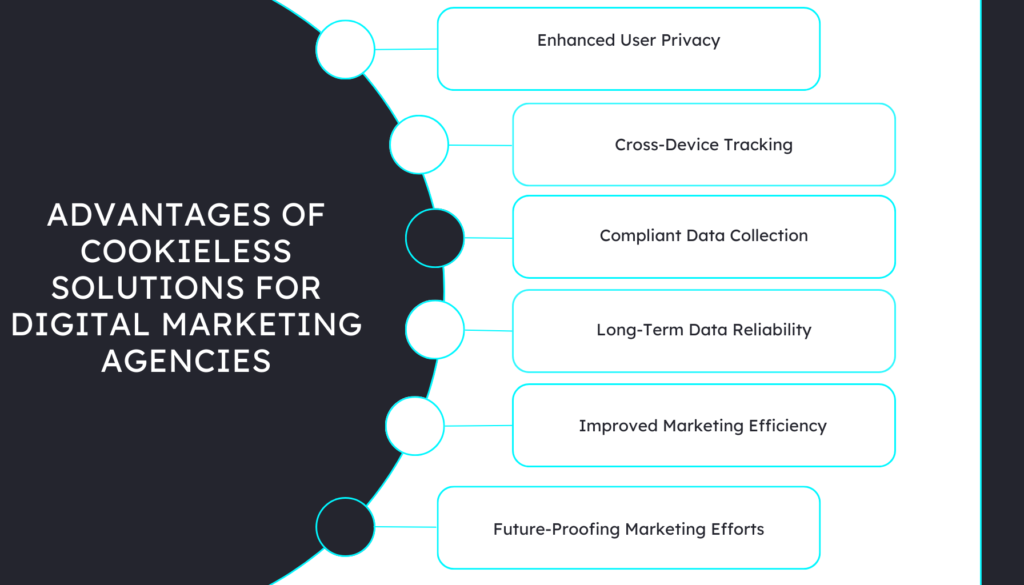
Data is the lifeblood that fuels strategies, insights, and customer understanding. As technology advances and consumer privacy concerns intensify, the once indispensable tool of web analytics faces a profound transformation. The traditional approach, reliant on cookies for user tracking, is now being challenged by privacy regulations and browser changes, necessitating a shift towards more privacy-conscious practices.
In this era of heightened data privacy awareness, the need for cookieless web analytics has become paramount for digital marketing agencies. As the gatekeepers of brands’ online presence, these agencies must adapt to the changing tides of the digital realm and adopt strategies that prioritize user privacy while maintaining the effectiveness of their marketing efforts.
This article dives into the significance of cookieless web analytics for digital marketing agencies, exploring the challenges posed by cookie-based tracking, the rise of cookieless solutions, and the benefits agencies can reap from embracing this transformation. By understanding the role of cookies, the advantages of cookieless analytics, and the best practices for adoption, agencies can navigate this paradigm shift with confidence and forge a path toward sustainable growth in the ever-evolving digital landscape.
The Role of Cookies in Web Analytics
Cookies are small text files placed on a user’s device when they visit a website, allowing the website to remember information about the user and their interactions during subsequent visits. Digital marketing agencies rely heavily on these cookies to track user behavior, measure website performance, and gain insights into user preferences, all of which are crucial for crafting effective marketing strategies.
A brief reminder of how they work:
- First-Party Cookies: These are created and stored by the website the user is actively visiting. First-party cookies enable website owners to track visitor sessions, user preferences, and other interactions directly related to their site. They are commonly used for analytics purposes, such as counting unique visitors and identifying returning users.
- Third-Party Cookies: Unlike first-party cookies, third-party cookies are created and stored by domains other than the one the user is currently visiting. Advertisers and marketing agencies often use third-party cookies to track users across multiple websites, enabling them to serve personalized ads based on the user’s browsing history and interests.
Limitations and Privacy Concerns Associated with Cookies:
While cookies have been instrumental in empowering web analytics and digital marketing, they come with several limitations and raise significant privacy concerns, leading to their declining efficacy as tracking mechanisms:
- Cross-Device Tracking Challenges: Cookies are primarily device-specific, which means they cannot efficiently track users across multiple devices like smartphones, tablets, and laptops. As users engage with websites through various devices, this fragmented view hinders agencies from obtaining a comprehensive understanding of user behavior and preferences.
- Cookie Blocking and Deletion: Modern web browsers and browser extensions increasingly offer users options to block or delete cookies, limiting the effectiveness of cookie-based tracking. As a result, the data collected may be incomplete or inaccurate, impacting the reliability of insights drawn from traditional cookie analytics.
- User Privacy and Consent: Privacy regulations, such as the General Data Protection Regulation (GDPR) and the California Consumer Privacy Act (CCPA), have heightened users’ rights to data privacy and control. Users are now more conscious of their data being collected and may withhold consent for cookie usage, making it difficult for agencies to access valuable user data and from targeted marketing strategies.
- Limited Attribution and Conversion Tracking: Cookies may not provide a complete picture of the customer journey, especially if a user interacts with multiple touchpoints or platforms. This limitation can lead to challenges in accurately attributing conversions to specific marketing efforts, hindering agencies from optimizing their campaigns effectively.
Impacts of Cookie-Based Tracking on Digital Marketing Strategies
The decline in the effectiveness of cookie-based tracking has significant implications for digital marketing agencies and their strategies:
- Reduced Personalization: Personalization lies at the heart of successful digital marketing campaigns, but without comprehensive user data, agencies may struggle to deliver tailored content and experiences to their target audiences.
- Incomplete Analytics Insights: Cookie blocking and user consent preferences can result in incomplete data sets, hampering agencies’ ability to derive actionable insights from their analytics efforts. This limitation might lead to less informed decision-making in marketing strategies.
- Compliance Risks: Non-compliance with privacy regulations can lead to severe penalties for agencies. Failing to adapt to privacy-conscious practices and relying solely on traditional cookie tracking can expose agencies to legal risks and tarnish their reputation.
In response to these challenges, the digital marketing industry has seen a paradigm shift towards cookieless web analytics, which aims to address privacy concerns while providing actionable insights.
The Rise of Cookieless Web Analytics
The emergence of stringent privacy regulations, such as the General Data Protection Regulation (GDPR) in the European Union and the California Consumer Privacy Act (CCPA) in the United States, has been a pivotal driver in the rise of cookieless web analytics. These regulations aim to empower users with greater control over their personal data and require you to obtain explicit consent before collecting and processing user information.
- User Consent: GDPR and CCPA mandate that users must be informed about the types of data being collected, the purpose of data processing, and any third-party sharing of data. Users now have the right to opt-in or opt-out of data collection, including cookies, without facing adverse consequences.
- Transparent Data Practices: Privacy regulations emphasize the need for transparency in data practices. Digital marketing agencies must now be more accountable for how they handle user data and ensure compliance with data protection laws, paving the way for the adoption of more privacy-friendly analytics solutions.
In addition, major web browsers, recognizing the growing concerns around user privacy, have started phasing out support for third-party cookies. These cookies, often used by advertisers and marketers for cross-site tracking, are now becoming less reliable as a tracking mechanism.
- Google’s Privacy Sandbox: Google, whose Chrome browser holds a substantial market share, announced plans to phase out third-party cookies by developing alternative privacy-preserving solutions through its Privacy Sandbox initiative. This move has spurred digital marketing agencies to explore alternative tracking methods.
- Apple’s Intelligent Tracking Prevention (ITP): Safari, Apple’s web browser, implemented Intelligent Tracking Prevention to limit cross-site tracking and the use of third-party cookies. This further reinforces the need for agencies to embrace cookieless analytics solutions that are compatible with evolving browser policies.

Advantages of Cookieless Solutions for Digital Marketing Agencies
- Enhanced User Privacy: Cookieless web analytics solutions prioritize user privacy by reducing reliance on tracking technologies that store personally identifiable information. This builds trust with users and fosters a positive brand image for agencies that respect user privacy.
- Cross-Device Tracking: Unlike traditional cookies, cookieless analytics leverage techniques such as device fingerprinting and deterministic or probabilistic matching to track user interactions across multiple devices accurately. This provides a more holistic view of the customer journey and enables agencies to deliver consistent and seamless experiences.
- Compliant Data Collection: Adopting cookieless solutions ensures compliance with privacy regulations like GDPR and CCPA. By relying on consent-based data collection methods, agencies can mitigate legal risks and avoid potential penalties.
- Long-Term Data Reliability: While cookies can be deleted or blocked, cookieless analytics solutions based on first-party data and other privacy-preserving mechanisms offer more resilient and dependable data sources for agencies. This leads to more accurate and meaningful analytics insights.
- Improved Marketing Efficiency: By focusing on first-party data and using advanced analytics models, cookieless solutions can provide valuable insights into customer behavior and preferences. This enables agencies to refine their marketing strategies, personalize content, and optimize ad targeting effectively.
- Future-Proofing Marketing Efforts: As privacy concerns continue to shape the digital landscape, investing in cookieless web analytics positions digital marketing agencies for the future. Embracing these solutions ensures they can adapt to changing regulations and browser policies without major disruptions to their data-driven marketing approaches.
How Can Digital Marketing Agencies Implement Cookieless Web Analytics?
As agencies transition to cookieless web analytics, they must explore alternative tracking technologies that comply with privacy regulations and deliver accurate insights. First-party cookies are an essential tool in the cookieless arsenal. Unlike third-party cookies, first-party cookies are directly issued by the website being visited, making them more privacy-friendly and less susceptible to blocking. Agencies can leverage first-party cookies to track user interactions within their own domains, ensuring data collection is transparent and consensual.
A more comprehensive method is digital fingerprinting, a promising solution to bridge the gap left by traditional cookies.
Digital fingerprint identification involves collecting a range of device-related data points, such as browser type, screen resolution, operating system, installed fonts, and more. When combined, this data creates a unique ‘fingerprint’ for each user, allowing agencies to identify users across multiple sessions and devices without relying on cookies or any personally identifiable information (PII).
Understand your customer journey analytics
See how your users behave, find drop-offs, and receive actionable insights with AI.

Pathmonk Intelligence, as a cookieless web analytics tool, harnesses digital fingerprint identification to provide agencies with invaluable insights into user behavior and preferences. By relying on non-intrusive, anonymous data, this method upholds user privacy while delivering accurate analytics.
Best Practices for Cookieless Web Analytics Adoption
Prioritizing User Consent and Transparency
In the era of heightened data privacy concerns, digital marketing agencies must prioritize user consent and transparency when implementing cookieless web analytics solutions. Obtaining explicit consent from users for data collection activities, including digital fingerprinting, is essential to comply with privacy regulations like GDPR and CCPA. Agencies should provide clear and easily accessible information about their data practices, explaining the types of data collected and the purposes for which it will be used. Transparent communication builds trust with users and fosters a positive user experience, demonstrating the agency’s commitment to safeguarding user privacy.
Integrating First-Party Data and Digital Fingerprinting
With the shift towards cookieless web analytics, the integration of first-party data and digital fingerprinting becomes pivotal for agencies seeking to gain valuable insights without relying on traditional cookies. Leveraging first-party data, collected directly from users’ interactions within the agency’s own domains, allows for privacy-friendly tracking while delivering accurate and reliable analytics insights. Digital fingerprinting further complements this approach by enabling cross-device tracking without capturing personally identifiable information (PII). By combining these methods, agencies can create a more comprehensive view of user behavior and preferences while maintaining a privacy-conscious approach to data tracking.
Collaborating with Cookieless Ad Tech Partners
As agencies adapt to the cookieless landscape, collaborating with cookieless ad tech partners becomes instrumental in executing effective marketing campaigns. One such valuable partner is Pathmonk Retargeting, a cookieless retargeting software that enables digital marketing agencies to run retargeting ads without relying on cookies.
2.5x better ad results with cookieless retargeting
Create high-converting retargeting ads based on your users' real-time intent.

Pathmonk Retargeting uses digital fingerprint identification to recognize users across various devices, allowing agencies to deliver personalized retargeting ads based on user interactions and real-time intent without compromising user privacy. This innovative approach ensures that retargeting efforts remain effective and privacy-friendly, aligning with the principles of cookieless web analytics.
Conclusion
The transformation of web analytics from a traditional cookie-based approach to a cookieless paradigm marks a turning point for digital marketing agencies. As privacy concerns, stringent regulations, and browser changes reshape the digital landscape, agencies must adapt and adopt innovative practices to thrive in this new era.
By prioritizing user privacy and data protection, agencies can build trust with their audiences, fostering positive relationships that drive loyalty and engagement. Enhanced data accuracy and cross-device tracking enable a comprehensive understanding of user behavior, empowering agencies to deliver personalized experiences and targeted marketing campaigns.
Cookieless web analytics is not just a choice for agencies—it is an imperative. The journey towards a privacy-conscious and user-centric digital landscape is underway, and it’s the responsibility of agencies to lead the way. By doing so, they can forge lasting connections with their audiences, drive meaningful results, and navigate the dynamic digital marketing landscape with confidence and success. The future is cookieless, and it beckons agencies to embrace it with innovation, creativity, and a commitment to user privacy.





